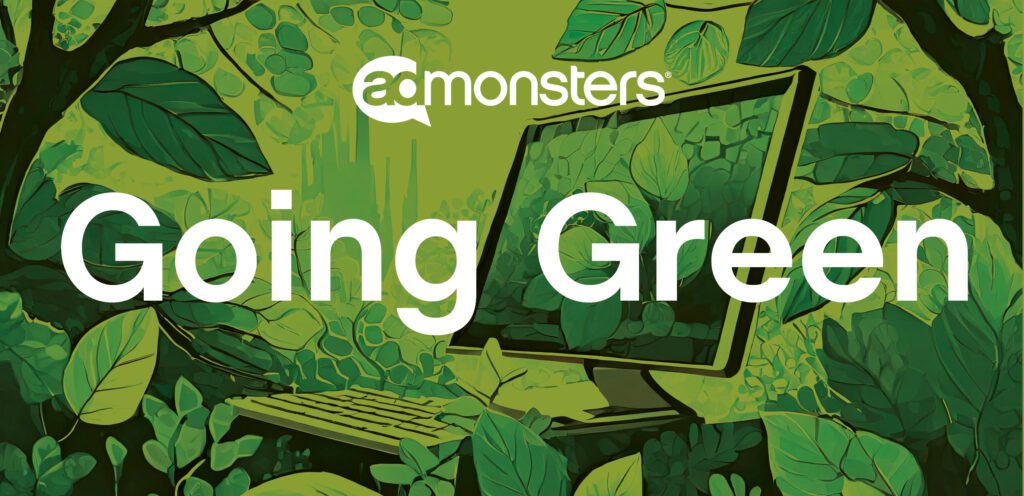
Kara Petrocelli explains how traffic shaping helped GumGum shrink its carbon footprint.
Earlier today, GumGum, a contextual advertising company, announced some good news for the planet. Thanks to its traffic-shaping partnership with Assertive Yield, the company has lowered its bidstream carbon emissions by 38% — avoiding an average of seven tons of CO2 emissions daily. To GumGum, traffic shaping is proof positive that what’s good for the planet is good for business as well as the entire ecosystem.
As part of AdMonsters’ Going Green series, we talked with Kara Petrocelli, GumGum’s Senior Director of Platform Operations, about the sustainability benefits of traffic shaping, as well as her company’s future sustainability initiatives.
AdMonsters: What was the impetus for GumGum’s traffic shaping initiative? Was it driven by business or environmental considerations?
 Kara Petrocelli: It was both, actually. We embarked on traffic shaping as part of our commitment to sustainability and environmental responsibility. We recognize that the environmental impact of digital advertising operations is quite large. Our goal is to lower the company’s carbon footprint while still finding ways to drive more efficiency within our ad serving process. We quickly realized that traffic shaping could lower our emissions, as well as the emissions of our upstream partners.
Kara Petrocelli: It was both, actually. We embarked on traffic shaping as part of our commitment to sustainability and environmental responsibility. We recognize that the environmental impact of digital advertising operations is quite large. Our goal is to lower the company’s carbon footprint while still finding ways to drive more efficiency within our ad serving process. We quickly realized that traffic shaping could lower our emissions, as well as the emissions of our upstream partners.
AdMonsters: That’s a big consideration. When an ad-tech company lowers its carbon emissions, its partners lower theirs as well.
KP: Every action taken within the advertising ecosystem has a direct impact on other companies, including sustainability actions. While traffic shaping is lowering our Scope 1 emissions, we’re simultaneously reducing the Scope 3 emissions of our demand partners.
Back in 2022 GumGum adopted sustainability as one of our key pillars, and that led us to ask what actions we can take to reduce and remove our emissions.
AdMonsters: How does traffic shaping lower carbon emissions?
KP: Traffic shaping is the method of reducing the amount of inventory that is being sent to demand partners. The goal is to reduce the inventory each demand partner isn’t likely to want, and to send them impressions they have an interest in purchasing. That can look different to different partners. We don’t want to send bid requests in regions that a demand partner doesn’t support, for example. So by eliminating those extraneous bid requests, we provide better service to our clients and reduce carbon.
Traffic shaping actually stems from the demand side. As DSPs began to put restrictions and caps on the amount of inventory that an SSP can send, it fell to the SSPs to determine the right mix of inventory to send on a partner-by-partner basis.
AdMonsters: How does Assertive Yield fit in?
KP: We opted to partner with Assertive Yield because they have AI algorithms that learn what a demand partner is interested in real time. Bidding behavior is far from static; seasonality, changing consumer behavior, there are a lot of factors that change what a demand partner may bid on. What someone is interested in for back to school in September can be very different from their interests during the holidays around November and December.
AdMonsters: So by optimizing the mix of inventory you send to each partner on a continuous basis, GumGum has lowered its carbon footprint?
KP: That’s right. And the nice thing is it’s not a one-and-done thing. By partnering with Assertive Yield that carbon reduction is always on because it’s always affecting our ever-changing bidding landscape. It gives us the assurance that those carbon reductions and bidding efficiencies are permanent.
AdMonsters: One of the pillars of sustainability is measurement and validation by a third-party. How are you measuring the carbon reduction of your bidstream?
KP: We’ve partnered with Cedara, which is a carbon intelligence platform, so they’re quantifying our carbon reduction. What’s cool about it is that the 38% isn’t just in GumGum’s Scope 1 reductions, there are others our partners are achieving through our traffic shaping. We can’t measure those now, but hopefully Cedara will be able to one day.
AdMonsters: Are you using Cedara to measure your bidstream carbon emissions only?
KP: No, we’re using Cedara to measure all of our emissions, even those outside of the traffic and inventory we send to our partners. Cedara is looking at everything, from office energy use to travel expenses, and how many commuters we have in each office.
Phase two, we will use Cedara to help us in things like partner onboarding. If we take onboard a new demand source, how will that affect our carbon emissions? What are the costs and load going to be on carbon? Cedara will provide us with an overall emissions score based on our data, which we will then be able to track on a quarter basis, as well as identify areas where we can reduce carbon.
AdMonsters: Sounds amazing. What’s your next carbon initiative now that you have traffic shaping implemented and running on a continuous basis?
KP: Our next big initiative is to encourage our downstream partners, such as publishers, to work with Cedara so that they too can measure and ultimately reduce their carbon emissions. Our goal is to lower not just our emissions, but the total emissions of the entire transaction.
Additionally, we’re working with Cedara to create emissions scores for campaigns so that advertisers understand the carbon impact of their advertising. This will allow them to make decisions, such as to opt for lower-carbon emitting ad units, or to purchase carbon offsets for campaigns they know are carbon heavy.
A lot of what we want to do is to get people to consider emissions in their day-to-day jobs and how it affects their campaign decision making. The fact is, there are a lot of green media products available, and choosing one for a campaign is an easy way for a brand to lower its Scope 3 emissions.
AdMonsters: What advice would you give to other senior directors of platform operations who are keen to lower their company’s carbon footprint?
KP: Start by advocating for your company to make sustainability a pillar, which means getting all the departments to put sustainability at the forefront of their decision making. So whether that is finance, operations, the number of people you hire to staff a particular office, all of these things add up to make a big difference.
I also think that while there are costs involved with partnering with a company like Cedara or Assertive Yield, there are also a lot of cost savings to be gained. We see that by driving efficiency through our ad operations.
AdMonsters: Good advice. Any parting words?
KP: I think a lot of demand sources put pressure on publishers to reduce carbon, but this isn’t a publisher-only issue. This is a challenge that everyone in the ecosystem needs to address — SSPs, DSPs, ad servers, and so on. Obviously it’s helpful if publishers looked at an SSP’s sustainability when choosing who to work with, but the truth is, everyone should look upstream and downstream.
__
Kara Petrocelli is GumGum’s Senior Director of Platform Operations and has been with the company for ten years. For the past decade, Kara has had a front-row seat in the various iterations of ad tech throughout the years. Today at GumGum, Kara mainly focuses on GumGum’s demand-side operations and third-party partnerships, from day-to-day internal and external operations to the technology and product involved throughout the process.
Kara is passionate about gender equity within the industry and beyond, serving for years as a co-lead for Women of GumGum. She graduated from the University of Colorado at Boulder and is based in Los Angeles with her baby boy, husband, and fur baby.